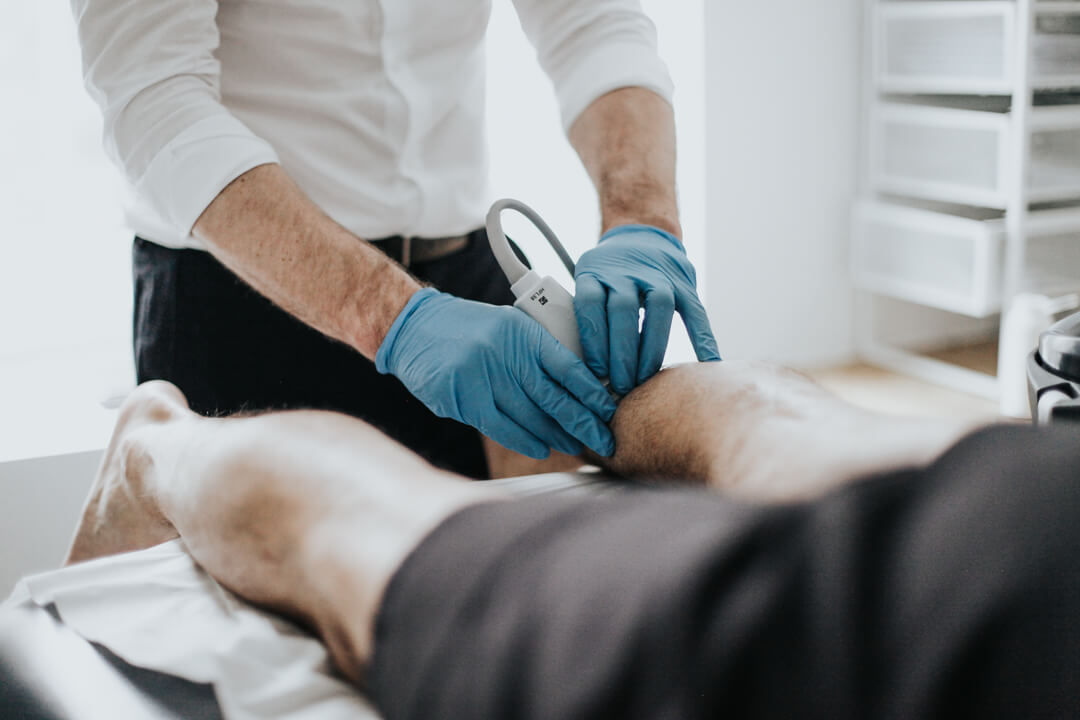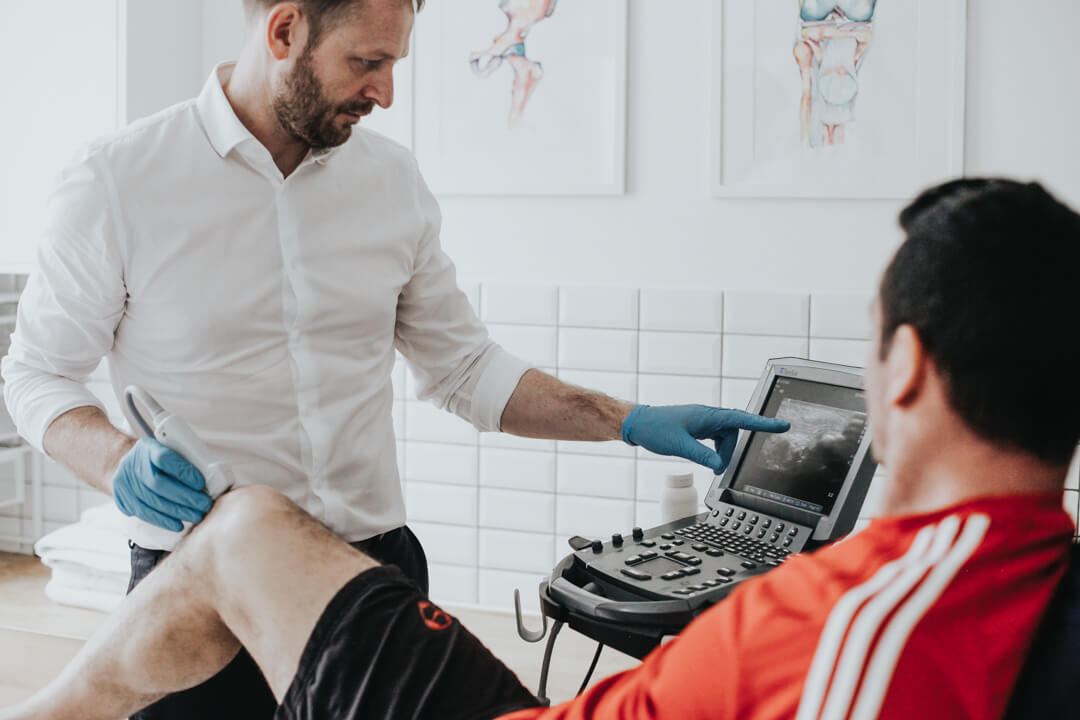Project Description
DIAGNOSTIC ULTRASOUND
DIAGNOSTIC ULTRASOUND
How is diagnostic ultrasound used at Complete Physio?
Complete Physio have pioneered the use of ‘point-of- care ultrasound’ (often referred to as POCUS) alongside their physiotherapy assessment and treatment for the past ten years.
Complete Physio believe that diagnostic ultrasound provides an important addition to traditional physiotherapy assessment and treatment, allowing accurate diagnosis of soft tissue injuries which significantly advances treatment and management of a wide range of conditions.
What conditions can diagnostic ultrasound help identify?
- Shoulder – rotator cuff tendinopathy and bursitis
- Foot and ankle – ligament injury, tendinopathy, bursitis, Morton’s neuroma, plantar fasciitis
- Knee – patella tendinopathy, quadriceps tendinopathy, osteoarthritis, bursitis, joint effusions, Baker’s/popliteal cyst, hamstring injuries
- Elbow – tennis elbow, golfer’s elbow, biceps injuries
- Wrist and hand – carpal tunnel, tendinopathy
“It was fantastic that the physio was able to scan my shoulder at the same time as the physiotherapy assessment. They were quickly able to assess the structures around my shoulder and in my particular case, they were able to identify tendinopathy.”
Diagnostic ultrasound has been shown to be as accurate as MRI particularly for tendon injuries, as well as many muscle and ligament injuries.
Ultrasound can also be useful in the assessment of nerve impingements, monitoring of tissue healing (such as muscles and tendons), as well as to confirm areas of swelling.
At Complete Physio we may also use it to accurately direct treatments to a specific area of tissue damage, e.g. for dry needling techniques, shockwave therapy, and ultrasound guided injections.
Many of our clinical specialist physiotherapists are able to perform the scan as part of your assessment (please request when booking if you would like to have diagnostic ultrasound as part of your assessment).
Why choose Complete Physio?
Complete Physio have been leaders in the use and progression of clinic-based ultrasound by physiotherapists for many years. Clinical directors, Dave Baker and Chris Myers, are involved in the university teaching programs, both in the UK and abroad. They both present on the use of diagnostic ultrasound and ultrasound guided injections for musculoskeletal conditions and sports injuries.

Conditions we don’t scan
Please note we do not scan for:
- Assessment of ‘lumps and bumps’
- Abdominal region, including hernias
- The spine, trunk or pelvis e.g. lumbar spine, thoracic spine and cervical spine/neck area
Why book for a diagnostic ultrasound scan?

Diagnostic ultrasound has become more commonly used by physiotherapists, sports doctors and orthopaedic surgeons in recent years to ensure the correct diagnosis is made at your initial assessment.
There are many reasons for the increased use of diagnostic ultrasound by physiotherapists. These include:
- Improved technology and image quality (for many conditions it is equal to MRI in diagnostic accuracy)
- Patient safety (non-invasive, no radiation, painless procedure)
- Results immediately available which can be considered alongside your physical assessment
- Dynamic scanning (scanning whilst patient performs movement) and comparison with the asymptomatic side
- Sequential assessment of healing, e.g. muscle tear
- Ultrasound guided procedures e.g. steroid, hyaluronic acid or PRP injections
- Cost effective. Ultrasound is less expensive than most alternative forms of imaging.
Diagnostic ultrasound can be used for identifying and diagnosing a wide range of conditions in the upper and lower limb.
Your diagnostic ultrasound will be carried out by your physiotherapist, who has completed additional specialist training as a musculoskeletal sonographer (a qualification which allows them to assess your muscles, joints and tissues using diagnostic ultrasound).
- Combined physical assessment with ultrasound scan.
- Safe and pain free imaging.
- No additional cost.
- Adjunct to physiotherapy assessment.
- Dynamic scanning.
- Comparison with asymptomatic side.
- Used for guided injections.
- No side effects.
Diagnostic ultrasound is offered to patients who have pain in their joints or soft tissues to aid diagnosis, alongside traditional physiotherapy assessment and tests.
Diagnostic ultrasound is useful in assisting with the diagnosis of muscle tears, tendon injuries, joint pain and ligament injuries.
After the shockwave session you will be able to move the body part normally. Many of our patients feel a significant reduction in pain following a shockwave treatment. However, normally within 2-4 hours after the session they experience some temporary soreness and tenderness in the area. This rarely lasts more than 24 hours and is a normal reaction to shockwave therapy. In most patients, this will not limit normal daily activities.
Yes. Diagnostic ultrasound is used as part of a full physical assessment. Diagnostic ultrasound can be integrated with your treatment to aid ongoing assessment, e.g. to assess and monitor the healing of a muscle tear. Ultrasound can also be used to guide treatments such as dry needling or joint and soft tissue injections.
Diagnostic ultrasound is not a painful procedure. It is non-invasive; the probe is simply placed on the skin using some coupling gel. There is no heat transmission or radiation, and it is entirely safe.
A diagnostic ultrasound typically takes around 10-15 minutes. However, certain structures can be scanned very quickly taking just a couple of minutes. The amount of time spent scanning is very dependent upon the condition. If the scan is likely to include an ultrasound guided injection the session will take approximately 30-45 minutes.
No additional charge is made for the diagnostic ultrasound. It is included in the cost of your consultation. You must ask for your assessment to include a diagnostic ultrasound when you make your appointment to ensure you get booked in with the correct therapist.
At Complete Physio the diagnostic ultrasound is performed as part of your physiotherapy assessment and treatment. Therefore, there is no additional charge and the cost of your assessment, including the ultrasound, will be covered by your insurance company.
Unfortunately, we are unable to provide patients with a copy of the images following the ultrasound. We do, however, provide a copy of the report which can be sent to the patient to pass on to their GP or other healthcare professionals if required.
Our clinicians do not perform ultrasound of any areas around the spine, neck or trunk. Please also note we do not offer ultrasound assessment for hernia or ‘lumps and bumps’.

